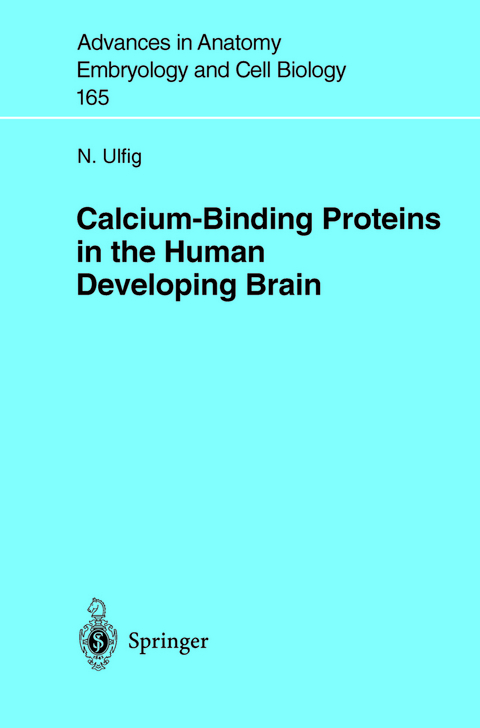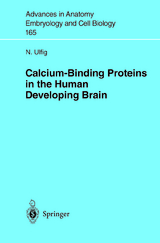Calcium-Binding Proteins in the Human Developing Brain
Springer Berlin (Verlag)
978-3-540-43463-4 (ISBN)
lt;br>"This book is primarily written for neuroscientists who will always be interested in the role of calcium in the internal neuronal environment. The objectives are well met. The authors are credible authorities in the field and are the most appropriate to discuss calcium in neuronal development...Through multiple excellent quality pictures, this book shows evidence of the potential roles of calcium in the modulation of development as well as on the determination of programmed cell death. " Review from Doody's Notes
1 Introduction.- 1.1 Calcium-Binding Proteins.- 1.2 CaBPs in the Mature and Developing Central Nervous System.- 1.3 Overview: Features of the Developing Brain.- 1.4 Scope of This Review.- 1.5 Materials and Methods.- 2 Cerebral Cortex: Subplate.- 2.1 Description.- 2.2 Expression of CaBPs in the Subplate.- 2.3 Functional Roles of the Subplate.- 2.4 Resolution of the Subplate.- 2.5 Effect of Fetal Hydrocephalus on the Distribution Pattern of CaBPs in the Subplate.- 2.6 Significance of the Subplate in Premature Infants.- 3 Cerebral Cortex: Cortical Plate.- 3.1 Description.- 3.2 CaBPs in the Cortical Plate.- 3.3 Effect of Fetal Hydrocephalus on the Distribution Pattern of CaBPs in the Cortical Plate.- 4 Cerebral Cortex: Molecular Layer (Layer I).- 4.1 Description.- 4.2 CaBPs in the Molecular Layer.- 4.3 Alterations in the Organization of Layer I in Trisomy 22.- 5 Ganglionic Eminence.- 5.1 Description.- 5.2 Developmental History.- 5.3 Neuronal Populations Originating from the Ganglionic Eminence.- 5.4 Calretinin and Calbindin Immunoreactive Cells in the Ganglionic Eminence and in the Intermediate Zone.- 5.5 The Ganglionic Eminence as an Intermediate Target.- 5.6 Significance of the Ganglionic Eminence in Developmental Neuropathology.- 6 Striatum.- 6.1 Description.- 6.2 Calbindin Expression in the Developing Striatum.- 6.3 Correlation of Calbindin Immunostaining and Expression of Synapse-Related Proteins in the Striatal Compartment of the Human Developing Brain.- 6.4 Significance of the Immunohistochemical Findings in the Striatum for Developmental Neuropathology.- 7 Amygdala.- 7.1 Description.- 7.2 Transient Architectonic Features of the Amygdala.- 7.3 Nerve Cell Types in the Fetal Amygdala as Seen in Calbindin and Calretinin Immunopreparations.- 7.4 Diffuse Calbindin and Calretinin Immunostaining in the Human Fetal Amygdala.- 8 Basal Nucleus of Meynert.- 8.1 Description.- 8.2 Calbindin Immunoreactive Neurons in the Basal Nucleus of Meynert.- 8.3 Effect of Fetal Hydrocephalus on Neuronal Morphology in the Basal Nucleus of Meynert.- 9 Hypothalamic Tuberomamillary Nucleus.- 9.1 Description.- 9.2 Parvalbumin and Calretinin in the Tuberomamillary Nucleus.- 10 Thalamic Reticular Complex.- 10.1 Description.- 10.2 Main Portion.- 10.3 Perireticular Nucleus.- 10.4 Medial Subnucleus.- 10.5 Pregeniculate Nucleus.- 10.6 Neuronal Types of the Thalamic Reticular Complex as Seen in Parvalbumin and Calretinin Immunopreparations.- 11 Red Nucleus.- 11.1 Description.- 11.2 Distribution Pattern of CaBPs in the Developing and Adult Red Nucleus.- 11.3 Relationship Between the Magnocellular and Parvocellular Parts.- 11.4 Neurochemical Characteristics of Rubric Nerve Cells.- 11.5 The Magnocellular Part of the Red Nucleus in the Adult Human Brain.- 11.6 The Magnocellular Part of the Red Nucleus in the Developing Human Brain.- 11.7 Significance of the Prominent Magnocellular Part for Neuropediatrics.- 12 Summary.- References.
| Erscheint lt. Verlag | 10.7.2002 |
|---|---|
| Reihe/Serie | Advances in Anatomy, Embryology and Cell Biology |
| Zusatzinfo | X, 96 p. 20 illus., 1 illus. in color. |
| Verlagsort | Berlin |
| Sprache | englisch |
| Maße | 155 x 235 mm |
| Gewicht | 224 g |
| Themenwelt | Studium ► 1. Studienabschnitt (Vorklinik) ► Anatomie / Neuroanatomie |
| Naturwissenschaften ► Biologie ► Humanbiologie | |
| Schlagworte | amygdala • Calcium • Calcium / Kalzium • cerebral cortex • Cortical plate • Developing brain • Hydrocephalus • hypothalamic tuberomamillary nucleus • nervous system • Neurobiologie • neurons • Protein • Protein / Eiweiß • Regulation • Striatum |
| ISBN-10 | 3-540-43463-1 / 3540434631 |
| ISBN-13 | 978-3-540-43463-4 / 9783540434634 |
| Zustand | Neuware |
| Haben Sie eine Frage zum Produkt? |
aus dem Bereich




